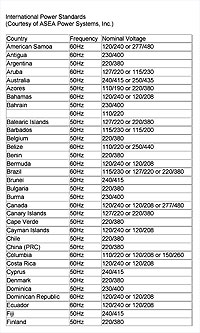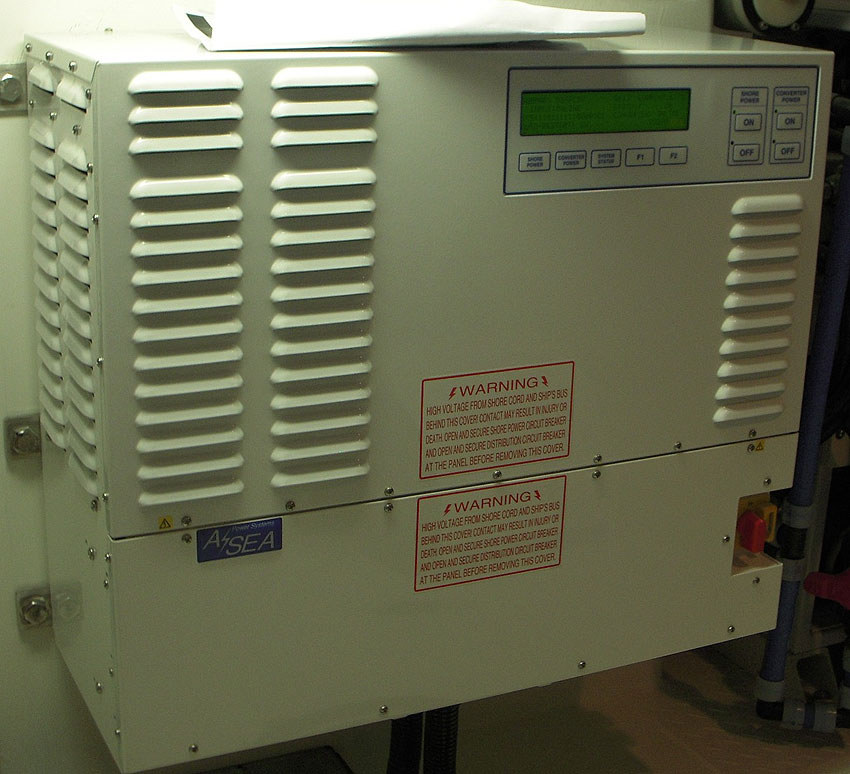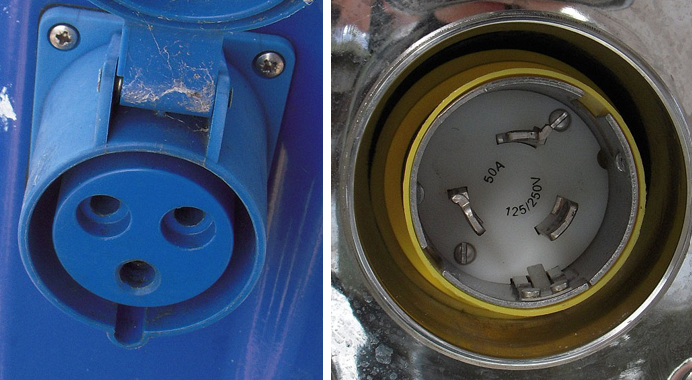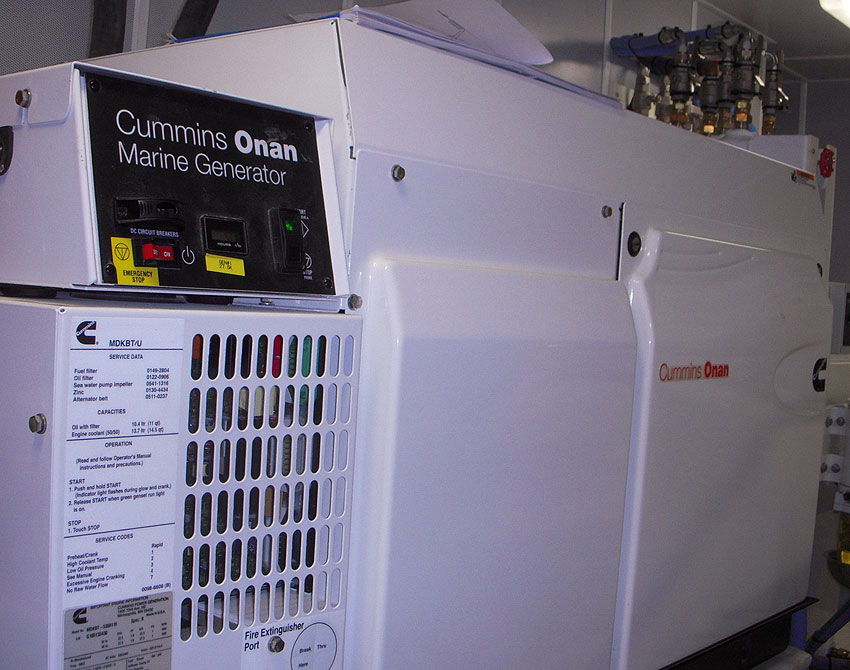Tech Talk - Shore Power Abroad
One of the trademarks of any Nordhavn is the ability to go virtually anywhere in the world. After nearly three decades in the business and hundreds of yachts built, you can bet that a Nordhavn has stopped over at just about every popular foreign port of call there is – and most in between.
Globetrotting from country to country like this presents a number of challenges, one of which is how to tie into shore power when voltages, frequencies and connections change from location to location. A quick look at the list below shows just how much voltages and frequencies can vary.

There are a number of ways to approach this problem. Before doing anything, however, it’s important to understand how a particular boat is set up. Smaller U.S. Nordhavns, like the N40 and N43, will have three-wire 120VAC 60Hz systems, while larger U.S. boats will typically have four-wire 120/240VAC 60Hz systems. Nordhavns built for the European market and most other countries will have three-wire 230VAC 50Hz systems.
And some of the much larger boats, like the N86 and N120, will typically have a three-phase, multiple-voltage system similar to what would be found on a large cruise ship.
Your ability to take advantage of foreign shore power will depend on what kind of power is available, the compatibility of your system, the equipment you have installed and whether or not you have any onboard shore power conversion devices. All of these factors will determine whether you can take full or partial advantage of the shore power available, or whether the best course of action is to leave the shore cord tucked in its locker and fire up the generator.

Powering Direct
To a limited degree, you might be able to just get an adapter, plug in and run some of your equipment directly off foreign shore power. This is pretty much limited to U.S. 120/240 60Hz boats going to 230VAC 50Hz areas (and vice versa) because the voltages and frequencies are only off by a small amount. A U.S. 120VAC 60Hz boat is not going to be happy trying to run off a 230VAC 50Hz foreign power supply.
Before doing this, it’s important to determine what kinds of equipment you have onboard that can be operated safely with different voltages and frequencies. While the short answer here is “not many,” there are some devices that can be used. Probably the most commonly cited is the water heater, which is just a big heating element that could care less if it’s getting 60Hz 240VAC or 50Hz 230VAC.
You might think your electric oven would work here, too, because it’s also just a big heating element, but the oven will also have electronics for control and monitoring that probably won’t agree with the wrong frequency.
In fact, anything with a motor or electronics is possibly going to have incompatibility issues with different voltages and frequencies. One common exception is a lot of older air conditioning equipment that is rated for 220-240VAC at 50/60Hz. This equipment will work with either power source, although performance will be about 17% less when operating at the lower frequency.
Presently air conditioning manufacturers are backing away from offering these dual ratings on newer equipment.
The important overall point here is to check your equipment before powering it with foreign shore power that is different than what your boat is set up for. If its data label doesn’t specifically state that it will run at different levels of voltage and/or frequency, don’t chance it.

Cheating the System
All Nordhavn electrical systems include at least one inverter/charger. In the charge mode the unit receives alternating current (AC) power from the generator or dock and converts it into direct current (DC) to charge the house batteries and power DC loads. In the invert mode it receives DC power from the house batteries or main engine alternator and converts it into AC power to run a number of vital loads, like the refrigerator, engine room blowers and outlet receptacle circuits.
This is especially convenient for smaller “battery” boats because it allows all essential services to be available underway or at anchor without having the run the generator – so the generator is typically only run for a few hours a day while making water, doing laundry, cooking and charging the batteries.
Another advantage of the inverter is its ability to be used in tandem with a dedicated battery charger to cheat the system by providing AC power to essential services using foreign power without having to invest in a costly shore power converter. Most battery chargers will accept a wide range of voltages and frequencies, so they can be powered virtually anywhere in the world.
This gives you a stable (albeit limited) DC supply to power DC services, charge the house batteries and power selective AC services via the inverter.
For example a U.S. Nordhavn with a 120/240VAC electrical system could include a 100-amp battery charger powered via a circuit breaker on the main ships service panel, which is powered by a shore power connection or generator via a selector switch. While plugged in at a foreign port only the BATTERY CHARGER breaker is turned on (and maybe the WATER HEATER breaker).
All other loads on this panel, like the water maker, oven and clothes washer, are turned off to prevent them from being damaged by incompatible foreign power. The battery charger provides up to 100 amps of 24VDC power to charge the house batteries, power 24VDC loads and power 120VAC loads via the inverter.
This solution does have its limitations. You’ll only be able to power inverter-supplied AC loads like the refrigerator (sorry, no air conditioning here), and you’ll be limited to the output capacity of the battery charger (a 100-amp 24VDC charger is good for about 2.4kW). If you go over that you’ll be draining your house batteries – which is fine during momentary peak loads, but should be avoided on the whole.
At best this should be considered a “get by” solution to be used in conjunction with judicious load management to prevent inadvertently discharging your batteries too deeply. Still, if the goal is to plug in while in a foreign port to keep the house batteries charged, keep the refrigerators and freezers running and watch a little TV, this is more than adequate.

The Ultimate Solution
On the other hand, if the goal is to be able to operate all services using foreign shore power, then a more substantial solution is called for. Many larger Nordhavns, and an increasing number of the smaller ones, are equipped with shore-power converters that will take in virtually any combination of voltage and frequency and put out whatever voltage and frequency the boat is set up for. This ensures maximum flexibility and full utilization of the available dockside shore power capacity.
Another nifty advantage here is that these units will put out whatever voltage they are programmed to regardless of where you are at on the dock – so there are no more worries about low voltage even if you’re parked all the way at the end. Also, these units work the same as an isolation transformer in terms of providing galvanic isolation from the dockside grounding system, which will prevent stray current issues from nearby boats causing corrosion problems on your boat.
In essence, these devices work the same as our earlier setup with a battery charger and inverter. They bring in the foreign AC shore power, convert it to DC, and then invert it back to AC at the specific voltage and frequency required by the boat’s electrical system. After that your only limitation is the capacity of the dockside shore power source.
While these shore power converters make things wonderfully easy for boat owners who like to see the world, they are not without their detractors. They are expensive (although getting less so), they eat up a decent amount of machinery space, and they put out a fair amount of heat – which often requires some extra ventilation. Also, they can create a weak point in the system if they malfunction.
You could have a 120/240VAC boat and be at a marina with 120/240VAC shore power, but if your shore power converter is down you still won’t be able to get power aboard. For redundancy, some Nordhavn owners have installed bypass systems with simple isolation transformers to ensure they can still get power aboard even if their shore power converter fails.

Making the Connection
Regardless of whether you’re powering a few select loads directly from foreign power, relying on a battery charger and house inverter to get power aboard for a limited arrangement or going full tilt with a shore power converter, you still have to solve the problem of properly connecting your shore power plug to the foreign shore power source.
In most cases you will be able to get an adapter that will make the necessary connection – this is where knowledgeable local marina operators and technicians can be very helpful. After time many seasoned boaters accumulate a locker full of different adapters for use in different ports of call.
And, as a backup, it’s a good idea to make up an adapter of your own with a plug on one end that will connect to your boat, and a junction box on the other end that can be used to wire directly into a shore power source – this can save time and effort if an adapter can’t be found for your specific situation.
Before making any connection, it’s a good idea to verify the voltage and frequency (and phase if using multiple cords) at the dock with a handheld meter just so there are no surprises. When making a connection it is very important to make sure line (hot) wires, neutral wires and grounding wires match up correctly to maintain the correct polarity and ensure proper grounding continuity.
In some cases this can get complicated. For example, a typical 120/240VAC 60Hz U.S. Nordhavn will have a shore power cord with two hot wires (L1 and L2) and a grounding wire going to the isolation transformer (this is a four-wire system, but the fourth [neutral] wire doesn’t come into play until the secondary side of the transformer on the boat).
If connecting this boat to a European three-wire 230VAC 50Hz shore power source, you end up connecting the L1 to the foreign hot, the L2 to the foreign neutral and the grounding to the foreign grounding. Confused yet? Again, another good reason for working with a competent local professional to ensure you’re making a proper shore power connection.

Be Smart
You should never be afraid to take advantage of foreign shore power as long as you’ve sorted out the details and are confident you can plug in without causing any harm. If you’re unsure it’s better to find a local technician who knows how to help you rather than to take any chances – this is not a learning curve you want to climb the hard way.
And always remember: You’ve got a generator – if the shore power in Timbuktu seems dodgy, just leave the shore cord in its locker and fire up the genny.